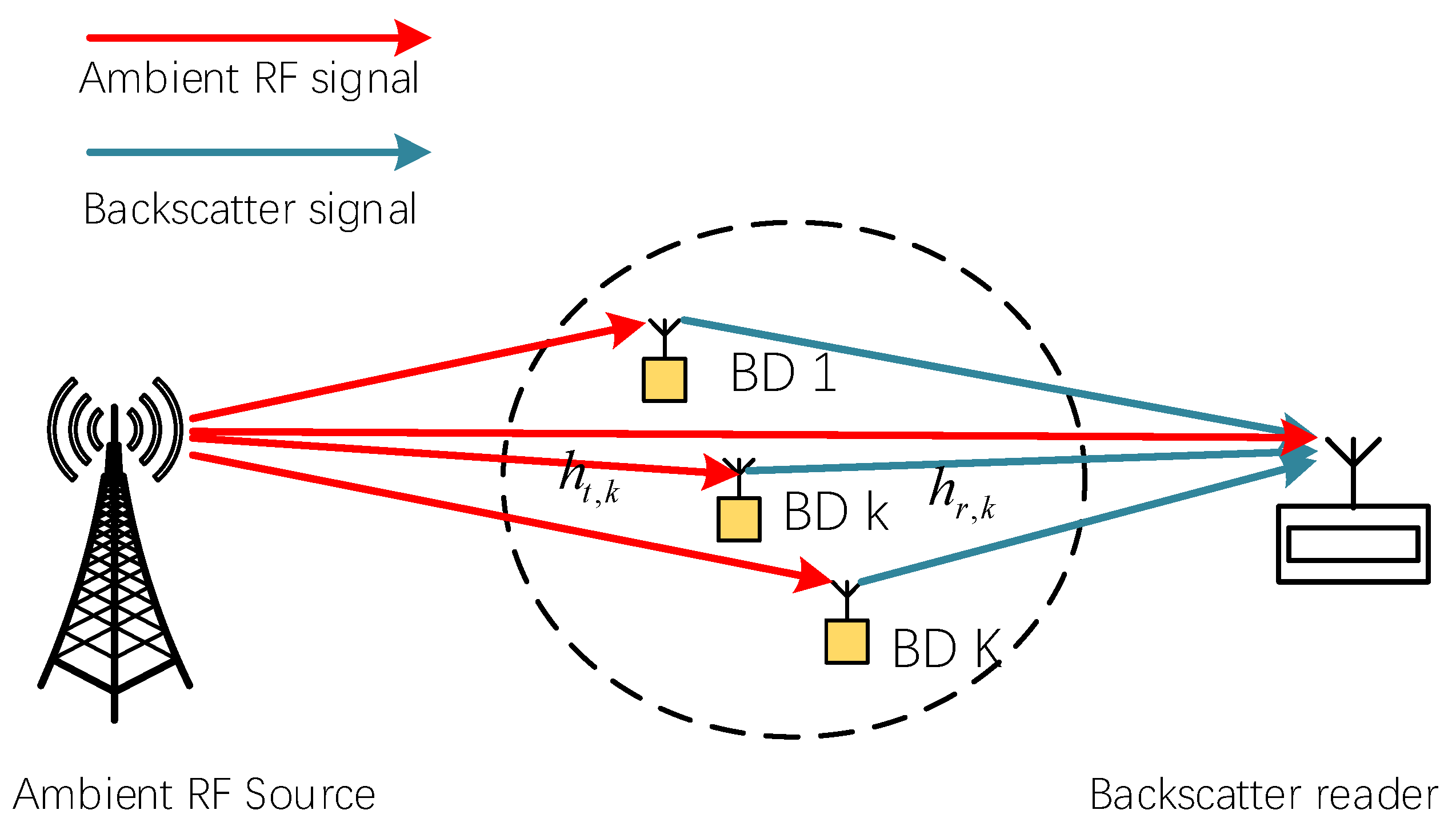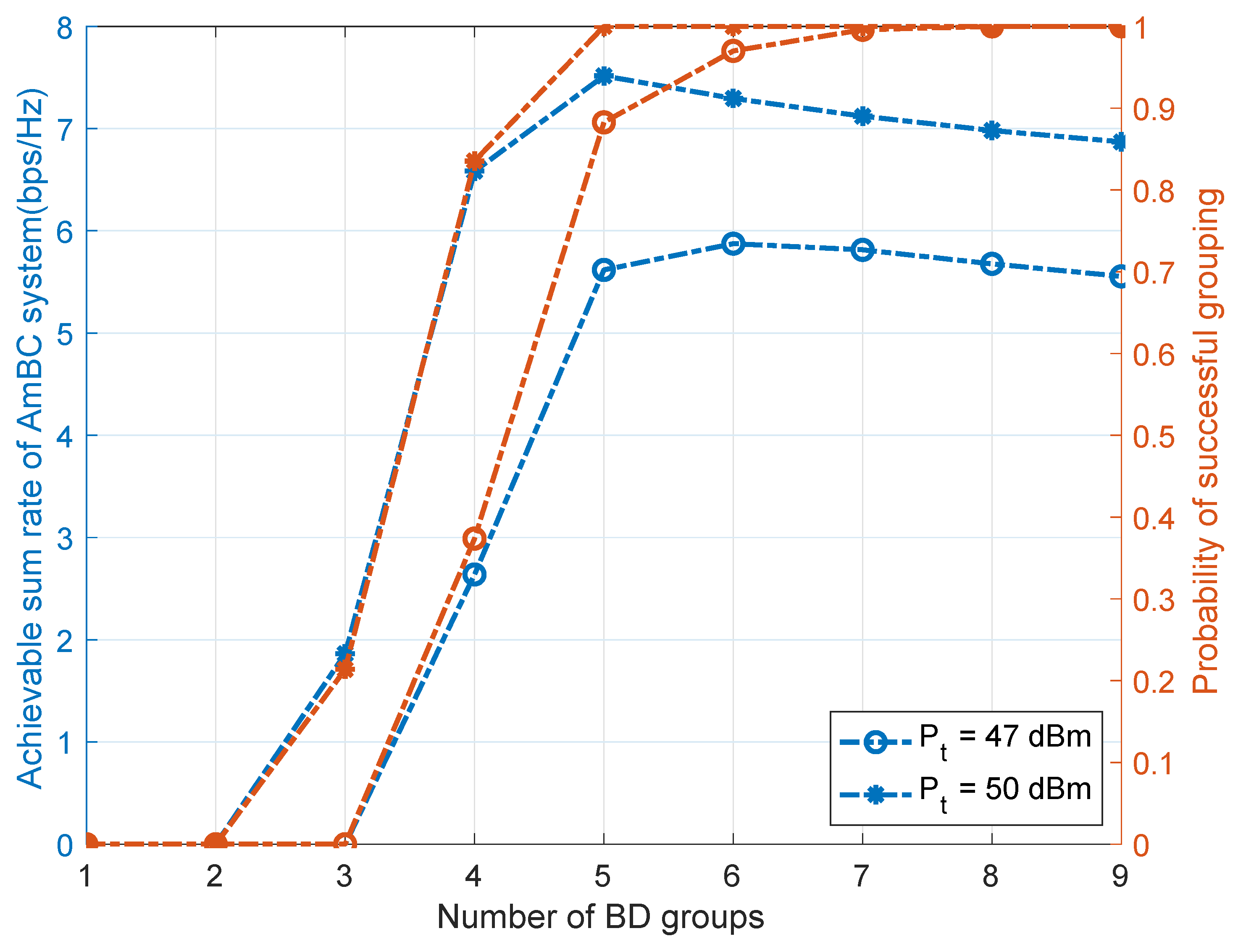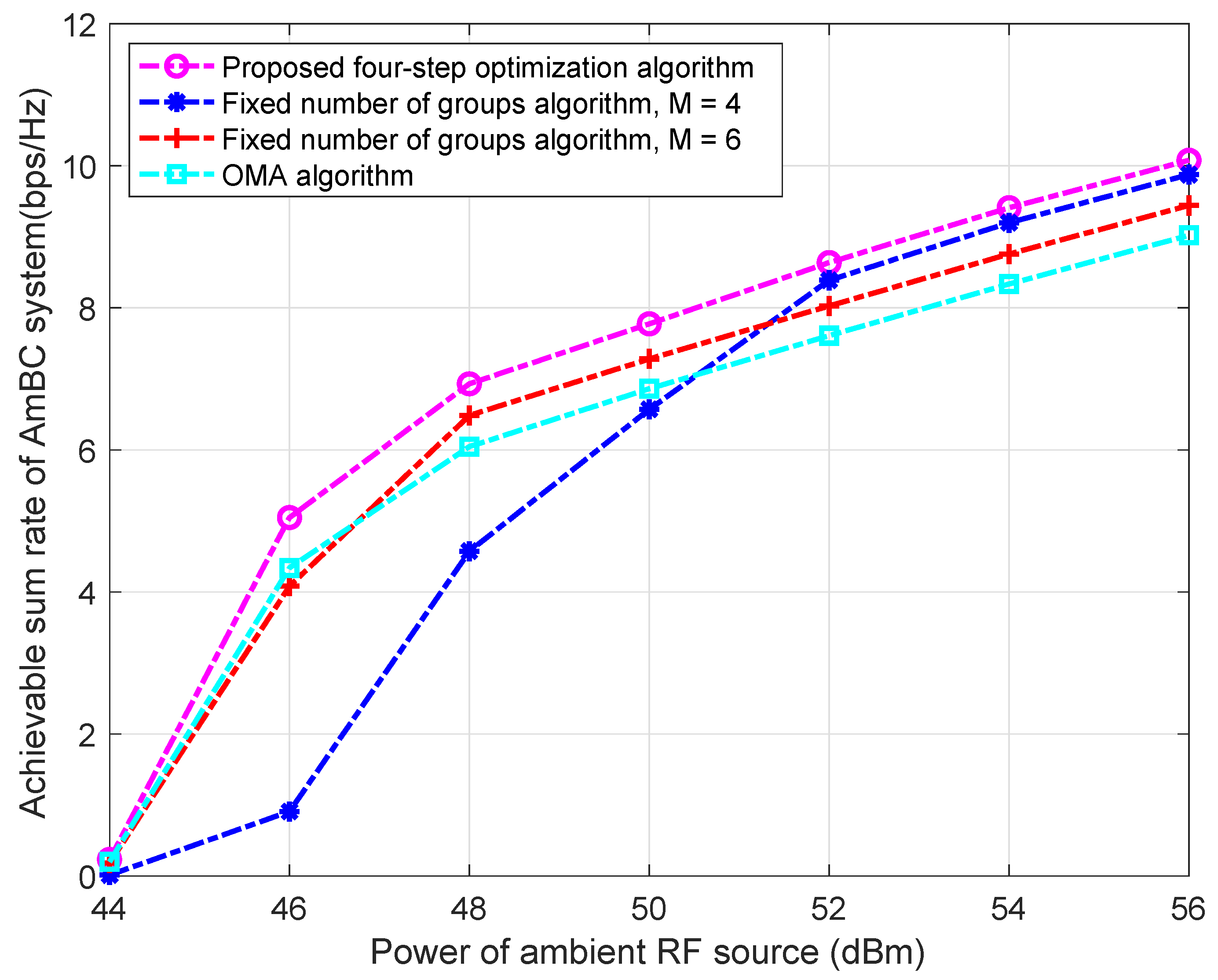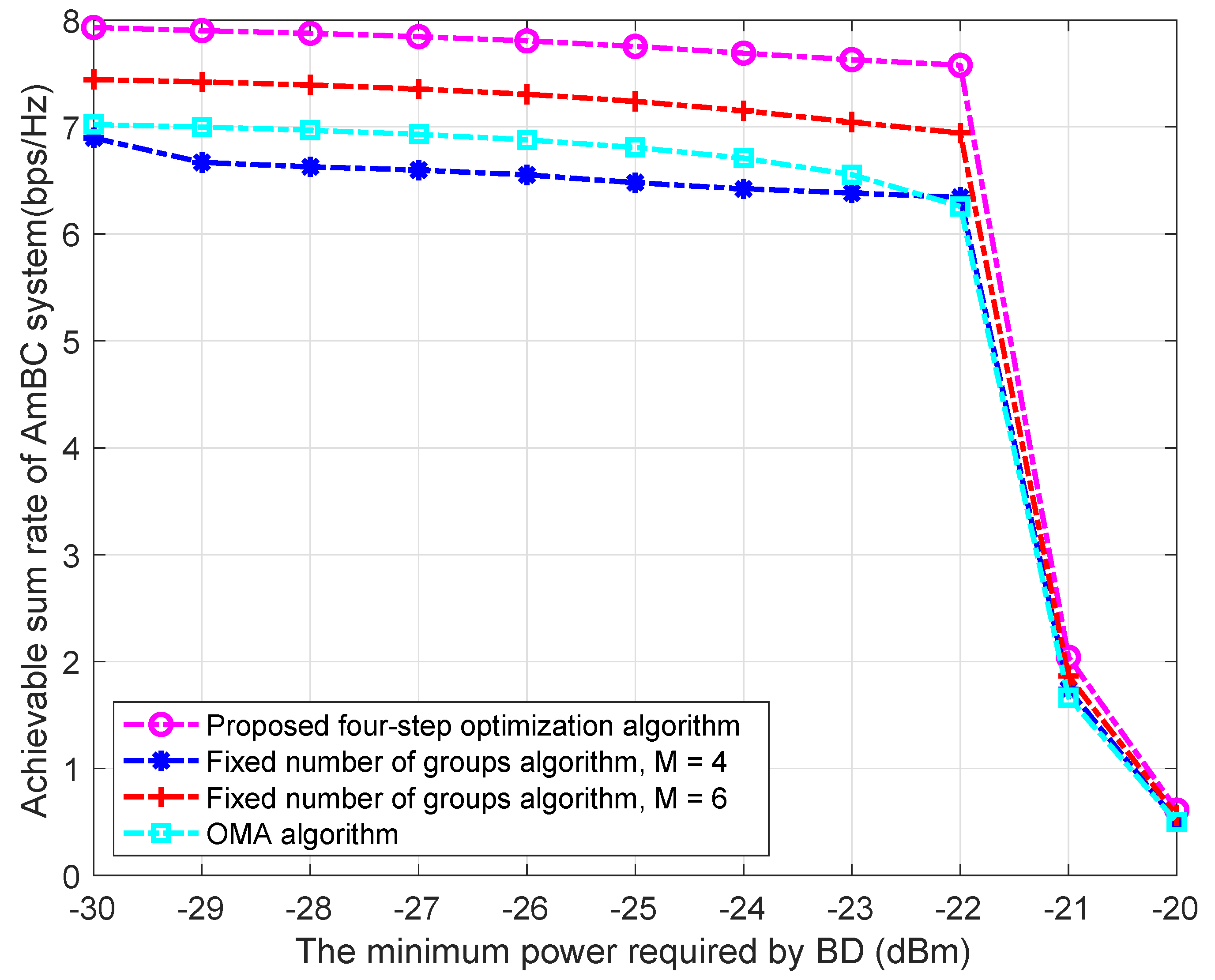Resource Allocation in NOMA-Assisted Ambient Backscatter Communication System
Abstract
:1. Introduction
- (1)
- We innovatively proposed the NOMA-assisted AmBC system. As far as we know, no research has been conducted to apply NOMA to the AmBC system to increase its ASR. Compared with the traditional AmBC system, the proposed system can significantly improve the ASR of the AmBC system.
- (2)
- To maximize the ASR of the AmBC system, we formed a joint optimization problem on the BD grouping strategy, reflection coefficient, and decoding order. The BD grouping strategy contains the number of BD groups and the BD allocation strategy. To simplify this problem, we converted the above problem into a four-step optimization problem. The computational complexity can be significantly reduced by solving the described four-step optimization problem.
- (3)
- Under the static grouping strategy, i.e., when the number of BD groups and the BD allocation strategy are known, we give the closed-form solutions for the optimal decoding order and reflection coefficients of BDs.
- (4)
- Under the dynamic grouping strategy, the BD grouping strategy is divided into two steps: the number of BD groups strategy and the BD allocation strategy. Therefore, for a given number of BD groups, we propose a low-complexity BD allocation strategy based on the complexity–performance trade-off. Once the BD allocation strategy is determined, we can solve for the optimal ASR based on the static grouping strategy. Then, the number of BD groups with the maximum ASR is selected as the global optimal number of BD groups.
2. Related Work
3. System Model and Problem Formulation
3.1. System Model
3.2. Problem Formulation
4. Static BD Grouping Solutions
4.1. Decoding Order
| Algorithm 1. Proposed decoding order algorithm |
| Input: , ,,}, {}, {} |
| 1: For do |
| 2: Calculate according to Equation (27); |
| 3: End for |
| 4: Arrange in descending order and get ; |
| 5: ; |
| Output: |
4.2. Reflection Coefficient
| Algorithm 2. Proposed reflection coefficients algorithm. |
| Input: , ,,}, {},, {}, |
| 1: Get according to Algorithm 1; |
| 2: Sort BD according to ; |
| 3: For do |
| 4: Calculate according to Equation (33); |
| 5: Calculate according to Equation (34); |
| 6: End for |
| 7: For do |
| 8: Calculate according to Equation (37); |
| 9: ; |
| 10: End for |
| Output: {} |
5. Dynamic BD Grouping Solutions
5.1. BD Grouping
| Algorithm 3. Proposed BD grouping algorithm |
| Input: , ,,}, {},, {}, |
| 1: Let , get according to Algorithm 1; |
| 2: Sort BD as the decoding order ; |
| 3: For do |
| 4: For do |
| 5: Get according to Algorithm 2; |
| 6: Calculate according to (39); |
| 7: End for |
| 8: ; |
| 9: ; |
| 10: End for |
| Output: {} |
5.2. Number of Groups
| Algorithm 4. Proposed four-step optimization algorithm |
| Input: , ,,}, {},, {}, |
| 1: for do |
| 2: Get according to Algorithm 1; |
| 3: Get {} according to Algorithm 2; |
| 4: Get {} according to Algorithm 3; |
| 5: Get according to Equation (42); |
| 6: End for |
| 7: ; |
| 8: |
| Output:,{}, , , |
6. Numerical Results
6.1. Simulation Setup
6.2. Benchmark Scheme
6.3. Proposed Algorithm
7. Conclusions
Author Contributions
Funding
Data Availability Statement
Acknowledgments
Conflicts of Interest
References
- van Huynh, N.; Hoang, D.T.; Lu, X.; Niyato, D.; Wang, P.; Kim, D.I. Ambient Backscatter Communications: A Contemporary Survey. Commun. Surv. Tutor. 2008, 20, 2889–2922. [Google Scholar] [CrossRef] [Green Version]
- Kang, X.; Liang, Y.; Yang, J. Riding on the Primary: A New Spectrum Sharing Paradigm for Wireless-Powered IoT Devices. IEEE Trans. Wirel. Commun. 2018, 17, 6335–6347. [Google Scholar] [CrossRef] [Green Version]
- Ishizaki, H.; Ikeda, H.; Yoshida, Y.; Maeda, T.; Kuroda, T.; Mizuno, M. A battery-less WiFi-BER modulated data transmitter with ambient radio-wave energy harvesting. In Proceedings of the 2011 Symposium on VLSI Circuits—Digest of Technical Papers, Kyoto, Japan, 15–17 June 2011; pp. 162–163. [Google Scholar]
- Qian, J.; Gao, F.; Wang, G.; Jin, S.; Zhu, H. Noncoherent detections for ambient backscatter system. IEEE Trans. Wirel. Commun. 2017, 16, 1412–1422. [Google Scholar] [CrossRef]
- Guo, H.; Long, R.; Liang, Y.-C. Cognitive Backscatter Network: A Spectrum Sharing Paradigm for Passive IoT. IEEE Wirel. Commun. Lett. 2019, 8, 1423–1426. [Google Scholar] [CrossRef]
- Yang, G.; Zhang, Q.; Liang, Y.-C. Cooperative ambient backscatter communications for green Internet-of-Things. IEEE Internet Things J. 2018, 5, 1116–1130. [Google Scholar] [CrossRef] [Green Version]
- Saad, W.; Bennis, M.; Chen, M. A vision of 6G wireless systems: Applications, trends, technologies, and open research problems. IEEE Netw. 2020, 34, 134–142. [Google Scholar] [CrossRef] [Green Version]
- Zahid, N.; Sodhro, G.H.; Janjua, M.B.; Chachar, F.A.; Sodhro, A.H.; Abro, S.A.K. HARQ with chase-combining for bandwidth-efficient communication in MIMO wireless networks. In Proceedings of the 2018 International Conference on Computing, Mathematics and Engineering Technologies (iCoMET), Sukkur, Pakistan, 3–4 March 2018; pp. 1–6. [Google Scholar]
- Ding, Z.; Lei, X.; Karagiannidis, G.K.; Schober, R.; Yuan, J.; Bhargava, V.K. A survey on non-orthogonal multiple access for 5G networks: Research challenges and future trends. IEEE J. Sel. Areas Commun. 2017, 35, 2181–2195. [Google Scholar] [CrossRef] [Green Version]
- Dai, L.; Wang, B.; Yuan, Y.; Han, S.; Chih-lin, I.; Wang, Z. Non-orthogonal multiple access for 5G: Solutions, challenges, opportunities, and future research trends. IEEE Wirel. Commun. 2015, 53, 74–81. [Google Scholar] [CrossRef]
- Li, D.; Liang, Y. Adaptive Ambient Backscatter Communication Systems with MRC. IEEE Trans. Veh. Technol. 2018, 67, 12352–12357. [Google Scholar] [CrossRef]
- Zhang, J.; Zhu, L.; Xiao, Z.; Cao, X.; Wu, D.O.; Xia, X. Optimal and Sub-Optimal Uplink NOMA: Joint User Grouping, Decoding Order, and Power Control. IEEE Commun. Lett. 2020, 9, 254–257. [Google Scholar] [CrossRef]
- Kimionis, J.; Bletsas, A.; Sahalos, J.N. Increased range bistaticscatter radio. IEEE Trans. Commun. 2014, 62, 1091–1104. [Google Scholar] [CrossRef]
- Lu, X.; Niyato, D.; Jiang, H.; Kim, D.I.; Xiao, Y.; Han, Z. Ambient backscatter assisted wireless powered communications. IEEE Wirel. Commun. 2018, 25, 170–177. [Google Scholar] [CrossRef]
- Duan, R.; Wang, X.; Yigitler, H.; Sheikh, M.U.; Jantti, R.; Han, Z. Ambient backscatter communications for future ultra-low-power machine type communications: Challenges, solutions, opportunities, and future research trends. IEEE Commun. Mag. 2020, 58, 42–47. [Google Scholar] [CrossRef]
- Zhang, Q.; Zhang, L.; Liang, Y.-C.; Kam, P.-Y. Backscatter-NOMA: A symbiotic system of cellular and Internet-of-Things networks. IEEE Access 2019, 7, 20000–20013. [Google Scholar] [CrossRef]
- Jameel, F.; Zeb, S.; Khan, W.U.; Hassan, S.A.; Chang, Z.; Liu, J. NOMA-enabled backscatter communications: Towards battery-free IoT networks. IEEE Internet Things Mag. 2020, 3, 95–101. [Google Scholar] [CrossRef]
- Xu, Y.; Qin, Z.; Gui, G.; Gacanin, H.; Sari, H.; Adachi, F. Energy Efficiency Maximization in NOMA Enabled Backscatter Communications with QoS Guarantee. IEEE Wirel. Commun. Lett. 2021, 10, 353–357. [Google Scholar] [CrossRef]
- Liao, Y.; Yang, G.; Liang, Y.-C. Resource allocation in NOMA- enhanced full-duplex symbiotic radio networks. IEEE Access 2020, 8, 22709–22720. [Google Scholar] [CrossRef]
- Ihsan, A.; Chen, W.; Khan, W.U. Energy-Efficient Backscatter Aided Uplink NOMA Roadside Sensor Communications under Channel Estimation Errors. arXiv 2021, arXiv:2109.05341. [Google Scholar]
- Khan, W.U.; Sidhu, G.A.S.; Li, X.; Kaleem, Z.; Liu, J. NOMA- enabled wireless powered backscatter communications for secure and green IoT networks. In Wireless-Powered Backscatter Communications for Internet of Things; Springer: Cham, Switzerland, 2021; pp. 103–131. [Google Scholar]
- Le, C.-B.; Do, D.-T. Outage performance of backscatter NOMA re- laying systems equipping with multiple antennas. Electron. Lett. 2019, 55, 1066–1067. [Google Scholar] [CrossRef]
- Lyu, B.; Guo, H.; Yang, Z.; Gui, G. The optimal control policy for RF-powered backscatter communication networks. IEEE Trans. Veh. Technol. 2018, 67, 2804–2808. [Google Scholar] [CrossRef]
- Zhang, Q.; Zhang, L.; Liang, Y.; Kam, P.Y. Backscatter-NOMA: An integrated system of cellular and Internet-of-Things networks. In Proceedings of the ICC 2019—2019 IEEE International Conference on Communications (ICC), Shanghai, China, 20–24 May 2019; pp. 1–6. [Google Scholar]
- Yang, G.; Xu, X.; Liang, Y. Resource Allocation in NOMA-Enhanced Backscatter Communication Networks for Wireless Powered IoT. IEEE Wirel. Commun. Lett. 2020, 9, 117–120. [Google Scholar] [CrossRef]
- Khan, W.U.; Li, X.; Zeng, M.; Dobre, O.A. Backscatter-Enabled NOMA for Future 6G Systems: A New Optimization Framework Under Imperfect SIC. IEEE Commun. Lett. 2021, 25, 1669–1672. [Google Scholar] [CrossRef]
- Li, X.; Zheng, Y.; Alshehri, M.D.; Hai, L.; Balasubramanian, V.; Zeng, M.; Nie, G. Cognitive AmBC-NOMA IoV-MTS Networks with IQI: Reliability and Security Analysis. IEEE Trans. Intell. Transp. Syst. 2021. [Google Scholar] [CrossRef]
- Ahmed, M.; Khan, W.U.; Ihsan, A.; Li, X.; Li, J.; Tsiftsis, T.A. Backscatter Sensors Communication for 6G Low-powered NOMA-enabled IoT Networks under Imperfect SIC. arXiv 2021, arXiv:2109.12711. [Google Scholar]
- Khan, W.U.; Javed, M.A.; Nguyen, T.N.; Khan, S.; Elhalawany, B.M. Energy-Efficient Resource Allocation for 6G Backscatter-Enabled NOMA IoV Networks. IEEE Trans. Intell. Transp. 2021. [Google Scholar] [CrossRef]
- Khan, W.U.; Lagunas, E.; Mahmood, A.; Chatzinotas, S.; Ottersten, B. Integration of Backscatter Communication with Multi-cell NOMA: A Spectral Efficiency Optimization under Imperfect SIC. arXiv 2021, arXiv:2109.11509. [Google Scholar]
- Zhuang, Y.; Li, X.; Ji, H.; Zhang, H.; Leung, V.C.M. Optimal Resource Allocation for RF-Powered Underlay Cognitive Radio Networks with Ambient Backscatter Communication. IEEE Trans. Veh. Technol. 2020, 69, 15216–15228. [Google Scholar] [CrossRef]







Publisher’s Note: MDPI stays neutral with regard to jurisdictional claims in published maps and institutional affiliations. |
© 2021 by the authors. Licensee MDPI, Basel, Switzerland. This article is an open access article distributed under the terms and conditions of the Creative Commons Attribution (CC BY) license (https://creativecommons.org/licenses/by/4.0/).
Share and Cite
Liu, Q.; Sun, S.; Hou, J.; Jia, H.; Kadoch, M. Resource Allocation in NOMA-Assisted Ambient Backscatter Communication System. Electronics 2021, 10, 3061. https://doi.org/10.3390/electronics10243061
Liu Q, Sun S, Hou J, Jia H, Kadoch M. Resource Allocation in NOMA-Assisted Ambient Backscatter Communication System. Electronics. 2021; 10(24):3061. https://doi.org/10.3390/electronics10243061
Chicago/Turabian StyleLiu, Qiang, Songlin Sun, Jijiang Hou, Hongbiao Jia, and Michel Kadoch. 2021. "Resource Allocation in NOMA-Assisted Ambient Backscatter Communication System" Electronics 10, no. 24: 3061. https://doi.org/10.3390/electronics10243061
APA StyleLiu, Q., Sun, S., Hou, J., Jia, H., & Kadoch, M. (2021). Resource Allocation in NOMA-Assisted Ambient Backscatter Communication System. Electronics, 10(24), 3061. https://doi.org/10.3390/electronics10243061





